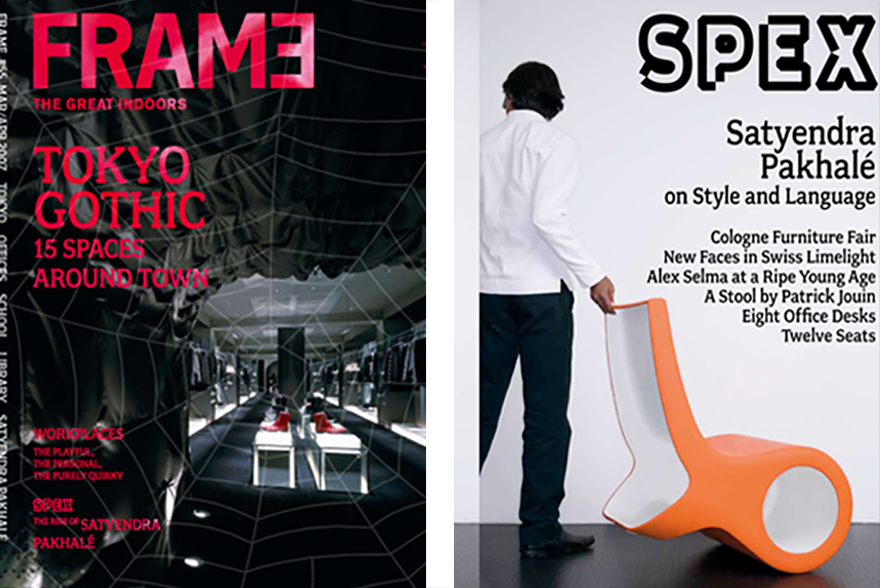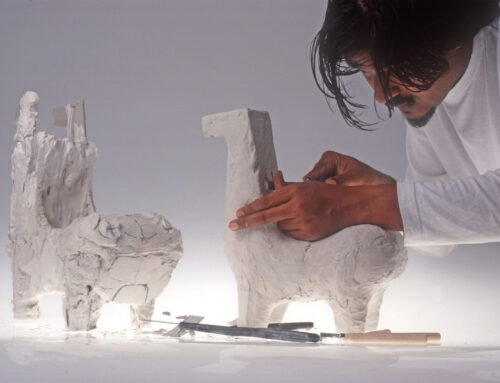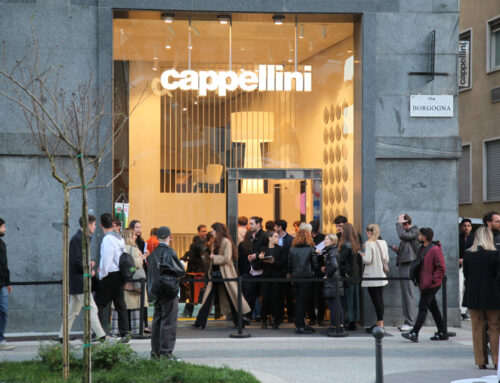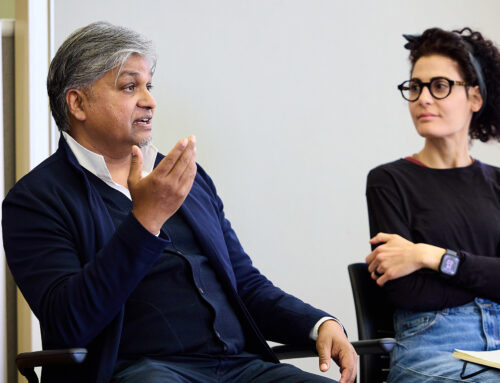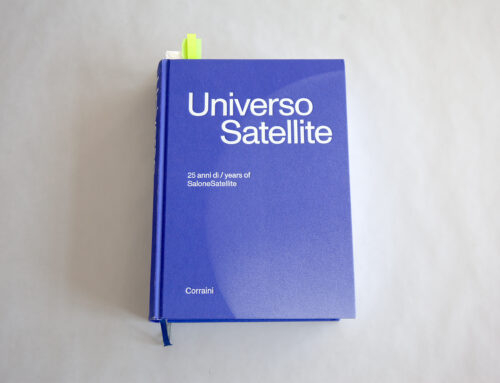Cologne Furniture Fair New Faces in Swiss Limelight Alex Selma at a Ripe Young Age A Stool by Patrick Jouin Eight Office Desks Twelve Seats
The Language of a Cultural Nomad
‘There is no wide gap between traditional and modern, low craft and high tech. All that counts is creativity.’ Industrial designer Satyendra Pakhalé (India, 1967) demonstrates his argument with a decorated bamboo stick, swishing it through the air and suddenly filling the room with delicate musical notes. ‘The sound is generated by the displacement of air. I found the flute while visiting an indigenous tribe in India, where cowherds use it to pass the time while tending cattle. It’s purely functional. Low tech? No, that’s not what I mean. First and foremost, it’s innovative – an effective response to a basic human need.’ Satyendra Pakhalé begins nearly every answer with a denial of what I’ve just suggested. A preference for tradition and crafts? Materials? Techniques? Indian roots? The designer carefully avoids being pinned down to definitive statements. Nor does he allow himself to be cornered. His sphere of activity covers industrial products and products made with traditional methods and produced in limited editions. Most of his designs display a similar style. Or perhaps I should say that Satyendra Pakhalé’s characteristic sculptural signature appears in designs like Horse Chair, Fish Chair and Panther Multi Chair – and less prominently in his other work. A distinctive style is not something he deliberately pursues. ‘I was asked to give a lecture on style, but I don’t want to discuss my work in those terms. Style is a superfluous qualification. Signature is better, but I’d rather talk about language. A language has origins, depth, history. It’s open. It evolves over time and allows for a variety of interpretations. Style excludes that sense of openness. It indicates closure, but as a designer you’re never done. As soon as you realize a design in a different material, you alter the language spoken by that object.’ Pakhalé raises the bar even higher. He wants nothing less than to find a universal language for his work. ‘Everyone knows and feels what good music is, what good food is. When I’m in Italy, people ask whether I’ve brought treacle waffles from Holland with me. You don’t have to be Dutch to appreciate stroopwafels. The same logic applies to good design.’
Satyendra Pakhalé was born in India and lives in the Netherlands, but he sees the whole world as his frame of reference. He doesn’t view his origins as a major issue, and, paradoxically enough, his lack of interest is based on those very origins. In his native land, an unrelenting caste system continues to determine the possibilities, and particularly the boundaries, of a person’s life, a situation that Pakhalé criticizes vehemently. Because he comes from a family of Buddhists, however – Buddhism propagates selffulfilment and ignores the caste system – he grew up less encumbered by such matters. Reinforcing the advantages tied to his belief was Pakhalé’s inherent gift for making things. ‘In India, it’s not at all unusual for children to make their own toys. It’s just the way things are. When I turned out to be good at it, my parents sent me to a special high school with an emphasis on technical skills. The decision to enter the design profession came about quite naturally.’ Pakhalé earned his Bachelor of Engineering and Master of Design degrees in India; his design studies were based on the modernist philosophy that underpins the Bauhaus movement. He later completed a two-year course in advanced product design in Switzerland, after which he remained in Europe.
‘Style is a superfluous qualification. Signature is better, but I’d rather talk about language
’Satyendra Pakhalé
‘I worked for Philips Design for two years [among his projects was the Pangea Concept Car], but then it was time for a change. Something was missing. I found the purely industrial context too dry. What I wanted was creation for creation’s sake, and not a job laden with the jargon and conditions of a corporate business. At the time I was doing some intensive research on tools and implements made by members of a certain Indian tribe, and the innovative and artisanal quality of those objects surprised me. You can do that kind of research even today, because such tribes can still be found in all corners of the globe. In my case, the study had to do with regaining my initial drive. In the West, market demand leads to the manufacture of more and more products for artificial needs that we’ve created ourselves. And it’s happening not only in the West. The same thing can be seen more and more in India and China as well. Industrial societies have lost touch with the essence of humanity. I wanted to get back to the heart of things. I accept industry wholeheartedly, and I want to work with industry, but the products have to be based on real human needs.’ Pakhalé believes that modernism is responsible for a limited conception of functionality and acceptable methods of production. ‘In my eyes, the bamboo flute that I demonstrated earlier is true design. The cowherds were bored. They wanted to dance, so they invented an instrument that’s easy to make. That flute has absolutely nothing to do with the modernists’ views on functionality, and it definitely testifies to their short- sightedness. They also restricted themselves when it came to technique. The modernists wanted products that would reflect the industrial potential of their era. That reflection became the International Style, a rigid diktat on style that no longer considered other possibilities in existence worldwide. Forms need expression, content – qualities that sometimes can be realized through industrial methods, but at other times you have to rely on a more traditional approach. I’m not a craftsman myself, but I believe in the refinement and pleasure that can be derived from making things. That doesn’t mean I revere craftsmanship for the sake of craftsmanship. Nor does it mean that I’m a romantic who’s out to leave artisanal traces, like fingerprints, in my work. But neither can I deny the process of making, which is, after all, crucial to the appeal of a product. I believe you can make products in an industrial context that have the unique appearance usually attributed to handicrafts.’ In 1998 Satyendra Pakhalé started his own design studio in Amsterdam, where he mostly develops products commissioned by manufacturers. Many of his designs start as craft projects, some but not all of which eventually evolve into industrial products. No form of handicraft is avoided, no high-tech method rejected and no material excluded. Pakhalé’s oeuvre is voluminous; his designs are part of museological collections around the world; and his list of clients features all the great names of the design world: Philips Design, Alessi, Cappellini, Magis, Moroso, Bosa, Material ConneXion, Offecct, Erreti and countless others. From his home in Amsterdam, Pakhalé travels the world to meet with clients and manufacturers. Does he feel like a Dutchman? ‘I understand the language, and I can speak some Dutch, but my professional language is English. It doesn’t matter where you live and work or what nationality you are. I’m a cultural nomad.’
‘Market demand leads to the manufacture of more and more products for artificial needs that we’ve created ourselves’ Satyendra Pakhalé
The story of Pakhalé’s career reads like a natural succession of events that occurred as a matter of course. The same can be said of his products. Nearly every object created goes on to be remade as a newer model, in a different material, and often as part of another collection. It’s a time-consuming process, as each transformation represents new technical challenges. He speaks with enthusiasm about his fascination with the ancient art of bell-metal casting, which he used to make several pots and bowls. The desire to reproduce the same designs on a larger scale required additional research, however. A brief description of the technique: Pakhalé models a form from clay, drapes spaghetti-like strands of natural wax against the inner walls of the vessel, fills it with wet clay, and bakes it in a kiln. The clay hardens and the wax melts, leaving a hollow space between the clay wall and core into which he pours molten bronze or aluminium. The cire perdue (lost wax) process has been used for centuries, but Pakhalé’s unique application of natural wax applied in thin strands is a further refinement of the craft. The disadvantages of this splendid example of artisanal work are that it’s quite labour-intensive and expensive, and thus unsuitable for mass-production. When Alessi showed interest in the designs, therefore, Pakhalé was forced to experiment with different materials. He came up with a stainless-steel vase and fruit bowl, as well as the STL Basket, an object produced by means of rapid prototyping (a computer model is translated directly from its virtual state into a physical object by means of laser sintering and stereolithography). ‘Even though stereolithography is high tech, it’s similar to the bell-metal method in several ways. The final product in both cases, for instance, is a smooth, seamless object.’ The Alessi prototypes came out in 2002. It’s a full five years later, and Pakhalé still envisions the possibility of modifying his designs in the future.
‘There is no wide gap between traditional and modern, low craft and high tech. All that counts is creativity’ Satyendra Pakhalé
If the Bell Metal Fruit Bowl was a challenge, an even greater hurdle was Pakhalé’s Horse Chair of 2000, a complex sculptural form that began as a one-off. In 2001 Cappellini made a limited-edition, flocked-fiberglass model of the chair. Now Pakhalé wants to fabricate a bell-metal version as well, but the complexity of the manufacturing process continues to stand in his way. Clearly, Pakhalé’s wide-ranging approach to design means that every product is accompanied by a distinctive course of development and its own technical challenges. Certain products come to life on the computer screen, untouched by human hands, whereas others require intensive interaction between virtual models and traditionally crafted prototypes, as exemplified by the Fish Chair (introduced in 2005 and recently manufac- tured entirely in plastic), which relies on reverse engineering for its definitive form. Here we see handicrafts and high tech as compatible partners. Recently Satyendra Pakhalé was named head of the Master of Design for Humanity program at the Design Academy Eindhoven. The school wanted a designer who could realize the ambitions of the department – sustain- able and humanitarian design – while also avoiding the many pitfalls lurking in this branch of the discipline, such as false sentiments, neocolonial Third World experiments and, not least, a surfeit of good intentions paired with a deficit of design skills. Pakhalé, who understands the complexity of the subject matter, emphasizes the importance of both good design and good research on the role of designers in this field. ‘The basis is a proper attitude towards the design process. Ultimately, every good product is the result of a human touch and a healthy relationship with our natural environment. Good design speaks a universal language that does justice to both tradition and progress.’
